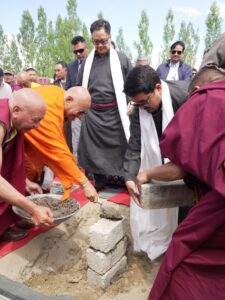Last Updated on June 11, 2021 at 3:14 pm
One should never forget to try sweet and sour tasty fruit ‘Apricots’ on their visit to Ladakh. Around 62 per cent of India’s apricots are produced in the cold desert of Ladakh according to a report issued by the Ladakh Autonomous Hill Development Council (LAHDC), Leh. Annually it produces 15,671 MT (Leh: 5,105, Kargil: 10,656) of this crop.
During 2013 and 2016, farmers of Dah, Hanu Thang and Biama (villages in the Dah-Hanu Valley) lost 80 per cent of their apricot crop because of a yellow-tail moth (Euproctis similis) pest infestation. As per reports, this was last seen about 50 years ago.

Apricots in Ladakh grow completely in late July to early September. The yellow-tail moth’s larvae (caterpillars) emerge in early May after overwintering and they feed on the apricot crop which is difficult to control which causes complete damage to trees from May to June. Leaves come back once the caterpillar goes into pupation and enters its adult stage. They have so much impact on the crop.
In 2015, the pest spread to the adjoining villages of Achinathang, Skurbuchan and Takmachik. The damage caused to the crop in 2016 made these five villages lose Rs 2.32 crore income.
Dr Tsering Stobdan, a leading scientist at the Defence Institute of High Altitude Research (DIHAR) told The Better India that he has never seen such massive pest infestation which caused so much damage. Though the pest problem had been going on since 2013 according to reports, but it came to the knowledge of the institute in 2016. None of the village residents complained about the pest problem. When the problem got worse then the problem was realized. Villagers thought it to be climatic changes happening.
Also Dr. Tsering Stobdan informed that he has never seen such pest infestation in his life. This insect is not known to be a pest of fruit trees even.
To solve this serious problem, LAHDC constituted a committee of agricultural scientists which was led by Dr Stobdan. Strategies to solve the problem were made. Two main suggestions came forward to tackle this situation. One was involving all government departments who work on agricultural issues, local community, village heads to handle the situation together.
Second was to make an Integrated Pest Management (IPM) approach making pest management strategies.
This approach could only be done by raising awareness among the farmers related to the pest’s life cycle. How the insecticides were to be used. Around 3 months were spent guiding the farmers regarding the life of the caterpillar and strategies to follow.
Also the whole community needed to be involved in controlling the pest problem. This was done by the politicians who brought people together which was a great help. Very helpful strategy which was done was making a pest free environment by destroying the fallen fruits and fruits remaining on trees after harvest and removing dead leaves from trees. Main issue was to destroy the things where insects could find shelter in winter. Another step which was taken was cutting or removing stems and branches that were dead, broken, diseased or overcrowded known as Pruning. Few other steps were also taken to handle the problem of pests.
If timely control measures were not done, the pest could have damaged the whole apricot industry of the region.
By 2019, however, a team of scientists led by Dr Stobdan, government officials, village heads, NGOs and the main stakeholders, farmers together eradicated the pest. Since 2019, there have been no reports of this particular pest.



